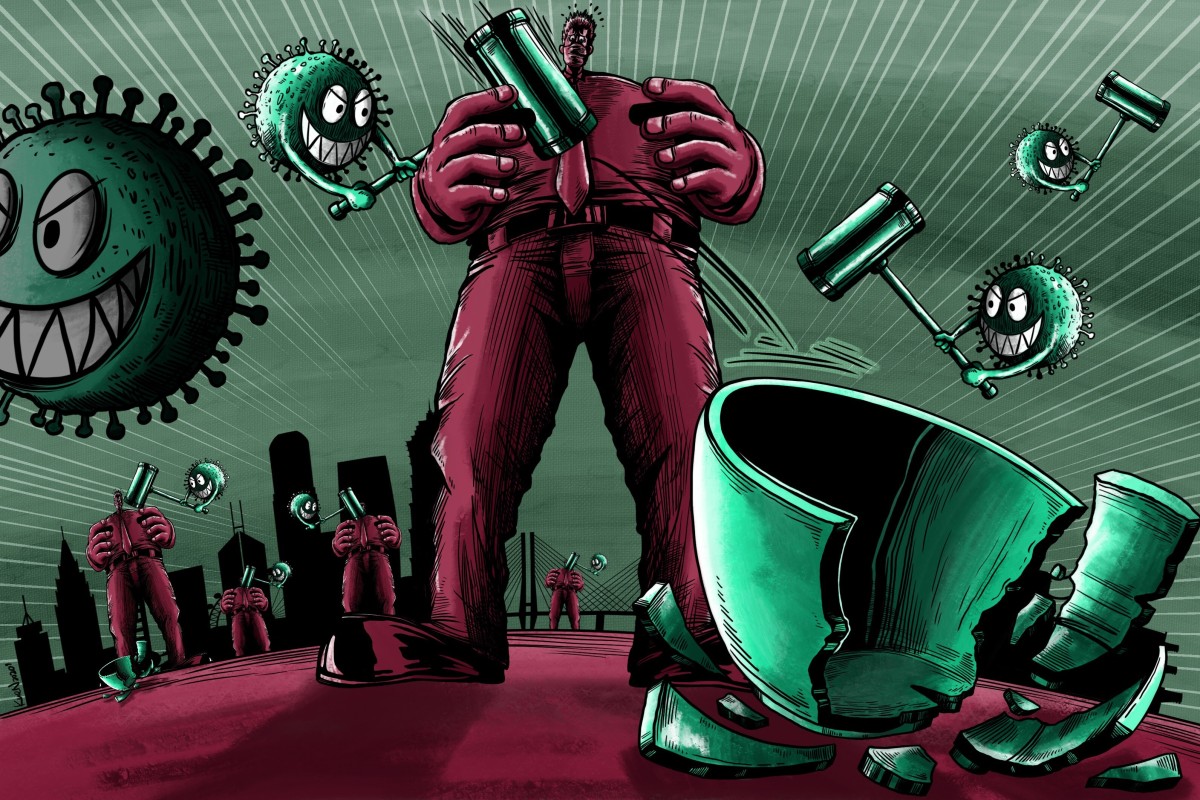As many as 205 million Chinese workers cannot find jobs or are unable to return to their previous posts, according to one analyst
Debate over China’s unemployment reality amid coronavirus heats up, with holes picked in official government statistics
UNEMPLOYMENT IS THE FINAL NAIL IN THE COFFIN OF THE MYTH OF THE PEOPLES REPUBLIC OF CHINA BEING SOCIALIST OR COMMUNIST IN ANYTHING BUT NAME, IT IS A NATIONALIST PROTECTIONIST STATE CAPITALIST ECONOMY
Frank Tang in Beijing 3 Apr, 2020

Now a debate is raging in China, as statisticians crunch their own numbers, trying to put a figure on how many people in China have lost their jobs due to the lockdown and the stop-start recovery effort. Illustration: Lau Ka-kuen
Yu Zhixiang received his redundancy notice in early-March, while he was on sick leave, weeks after the coronavirus outbreak forced Chinese economy to come to a standstill.
The 47-year-old had worked as a contract translator on Beijing’s Financial Street, home to many of China’s largest banks and the nation’s central bank. He was one of millions, maybe even tens of millions, of Chinese people who lost their jobs during the outbreak, but who were not immediately reflected in national unemployment data.
In the United States, data on the number of Americans filing their first claim for unemployment benefits each week offers a relatively up-to-date reading of the national jobless situation. But in China, jobless indicators are released on a monthly or even quarterly basis, and cover only part of the workforce.
The most widely cited figure, the surveyed urban unemployment rate issued by the National Bureau of Statistics (NBS), jumped to an all-time high of 6.2 per cent in January and February combined, up from 5.2 per cent in December. This roughly equated to an additional 5 million people thrown out of work.
The indicator, however, almost certainly underestimates the real jobless picture in the world’s second largest economy, since it excludes the many migrant workers who lost their jobs or could not return to work because of the travel restrictions put in place to prevent the spread of the coronavirus.
Now a debate is raging in China, as statisticians crunch their own numbers, trying to put a figure on how many people in China have lost their jobs due to the lockdown and the stop-start recovery effort.
Liu Chenjie, chief economist at fund manager Upright Asset, wrote in an article this week that the pandemic may have pushed 205 million workers into “frictional unemployment”, where they want to work but cannot or are unable to go back to work.
If true, that figure would represent more than a quarter of China’s 775 million workforce and would be vastly higher than the 6.2 per cent figure posited by the government’s survey.
It is not a like-for-like comparison, but Liu’s calculations emphasise the limitations of the official data, which only cover the urban workforce, of 442 million, but exclude the
290 million migrant workers often more vulnerable to economic fluctuations.
In addition, China’s monthly survey is conducted using a small sample base of about 120,000 households, only 0.03 per cent of the nation’s urban workforce.
At 6.2 per cent, the official jobless survey of urban workers would mean 27.4 million people are out of work, according to South China Morning Post calculations, compared to Liu’s 205 million nationwide figure.
The article, published by Caixin magazine, said that in the first two months of the year about 5 million jobs were cut at large industrial enterprises, those with annual revenue over 20 million yuan (US$2.8 million). Another 20 million job losses took place in small industrial firms, Liu wrote.
Coronavirus: Chinese companies cut salaries and staff in industries hit hardest by Covid-19
But the bulk of job losses in China took place in China’s service sector, where employment conditions are highly dependent on consumers’ willingness and ability to spend, which has been sharply curtailed by the pandemic.
In total, about 180 million service sector jobs disappeared due to the coronavirus outbreak, Liu calculated, based on a series of government statistics.
“Employment in industrial production and services may improve as the Chinese economy gradually returns to normal,” Liu wrote. But the speed and degree of improvement could be hindered by the spread of Covid-19 across the globe, he warned.
Another government metric, the urban registered jobless rate, is published quarterly and measures only the urban residents willing to file tedious reams of paperwork to register as being unemployed. This indicator has been stable at a rate of around 4 per cent for years, with few fluctuations over economic cycles.
Due to the lack of official data covering China’s entire workforce, economists and analysts have started to rely on private surveys, online job listings, anecdotal reports and even indicators such as subway rides in major cities to get a clearer view of the impact of the coronavirus outbreak on the unemployment situation in China.
It is not yet certain if these workers have lost their jobs, but the uncertainty over their job situations has become apparent
Hao Hong, Bocom International
Hao Hong, the head of research at Bocom International in Hong Kong, wrote in a research note last week that up to one-third of Chinese workers have not gone back to work, even though many have returned to the area where their job is located, partly based on urban subway ride statistics.
“It is not yet certain if these workers have lost their jobs, but the uncertainty over their job situations has become apparent,” Hong wrote, warning that the job losses could be more severe in China’s smaller cities, because they have generally fewer employment opportunities.
A visit by the Post to Dongguan, a manufacturing hub in the Pearl River Delta, found many factories cutting jobs and recruitment, as export orders have begun to vanish. Many of China’s 180 million export-oriented jobs will be at risk if global consumer demand continues to shrink as the pandemic spreads.
It is too early to say how many of those who were temporarily unemployed in February or March will suffer from extended unemployment. But it is clear that China is facing its largest unemployment challenge since the ruling Communist Party recognised that “unemployment” did, in fact, exist in the early-1990s. Before that, Beijing considered unemployment a product of capitalism.
Unlike two previous rounds of mass unemployment, when China laid-off tens of millions of state-owned factory workers in the late-1990s as it restructured its economy, or when the global financial crisis in 2008 left 20 million migrant workers out of work, the coronavirus shock is hurting employment across almost all sectors in the economy.
The few exceptions, such as online shopping and live streaming industries, have prospered as people have been forced to stay at home.
As the worrying employment outlook became clear, the Chinese government
shifted its focus. In March, Premier Li Keqiang said the economic growth rate is “not a big deal”, as long as China can maintain a stable jobs market.
Behind Beijing’s relentless pursuit of economic growth has been the desire to create enough jobs, thereby maintaining social stability.
However, with the economy set to contract in the first quarter, it is unclear whether there will be enough jobs created to accommodate the 9 million new graduates joining the workforce this summer, never mind the millions of migrant workers looking for work.
Beijing’s challenge is particularly severe given the lack of an adequate social safety net in China.
Unemployment benefits are small and reserved for only a few – a maximum of 2.5 million people claimed unemployment benefits in each quarter over the past decade, in a country of almost 1.4 billion.
In the late-90s, China’s private sector boom absorbed those laid off by the state, while following the financial crisis the booming service sector and government stimulus spending created jobs for migrant workers. Now, there does not appear to be any quick-fire solution for China’s hoards of newly unemployed citizens.
Lu Zhengwei, chief economist at Industrial Bank, said China’s “hidden unemployment” will become more visible in 2020.
“Rural migrant workers who lost their paid work are generally not included in government data,” Lu said. “Many of them may find it hard to maintain their previous living standards. Many migrant workers will have to go back to their farmland to support a basic lifestyle.”
Yu, the former contract translator who has no farmland to tilt, said he wouldn’t bother applying for unemployment benefits but would instead try to find freelance work.
“There are still some opportunities,” he said. “But wages are apparently lower than before.”
This article appeared in the South China Morning Post print edition as: Can China handle historic crisis in unemployment?

Frank Tang joined the SCMP in 2016 after a decade of China economy coverage and government policy analysis.
No comments:
Post a Comment